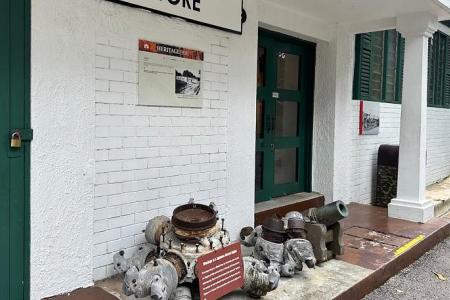Historic significance of WWII aircraft engine at Fort Siloso
The wrecked engine of a Japanese warplane shot down in 1942 in the final days of the battle for Singapore during World War II is a significant artefact that needs to be kept in better conditions, said some historians.
The battered and rusting engine from an Imperial Japanese Army (IJA) Mitsubishi Ki-51, also known as the Type 99 assault plane, was recovered from a construction site in Toa Payoh in 1988, and is currently displayed at Fort Siloso on Sentosa.
The engine, which once powered a plane from the Japanese 27th Hiko Sentai (Flying Regiment) that menaced Singapore’s defenders, now sits on a porch outside the former stores building at Fort Siloso.
While it has some overhead shelter, the hunk of metal is exposed to direct sunlight, as well as rainwater during downpours.
Associate professor for history at the National Institute of Education Kevin Peter Blackburn said the engine should ideally be displayed indoors to extend its lifespan.
“It would tend to deteriorate less if it was indoors. However, most of the damage to it seems to have been done in the war and being in the ground until 1988.”
Compared with the extensive literature on Japan’s 1941 bombing campaign against Singapore and Malaya, which targeted strategic sites like harbours, airfields and defensive strong points, scant attention has been paid to the role its other aircraft played in direct support of the invading troops.
Yet, the Type 99 assault plane was one of the key aircraft of the Japanese campaign to seize the Malay Peninsula, said curator of the Australian War Memorial (AWM) Garth O’Connell.
He described the missions flown by these planes as hard work at low altitudes, where risk from enemy anti-aircraft fire was far more dangerous than in missions at high altitudes.
“The Type 99 was involved in low-level reconnaissance and ground attack missions using machine guns and bombs all the way from northern Malaya to Singapore, flying daily missions harassing Indian, British and Australian ground forces in maintaining the ‘driving charge’ led by General Yamashita,” said Mr O’Connell.
He recounted to The Sunday Times that an Australian soldier of the Australian 8th Division defending Tengah Airfield in February 1942 had told him that Japanese close support aircraft were constantly overhead looking for targets of opportunity.
General Tomoyuki Yamashita, also known as the Tiger of Malaya, was the commander who led the IJA’s conquest of Malaya and Singapore.
British anti-aircraft fire was how this warplane met its end.
When the engine and a twisted propeller were unearthed during construction works in 1988, ST interviewed a 56-year-old resident living at a nearby Jalan Rajah flat who recounted seeing a Japanese plane being shot down during the war, when he was just eight years old.
“It crashed in what was then swampland and went to pieces,” said religious teacher Panna Dhipo.
Despite being unheralded, the 27th Regiment and its assault planes played a deadly role in the invasion of Singapore. A fuel and ammunition expenditure report from the Japan Centre for Asian Historical Records in Japan’s national archives showed that the 27th Regiment expended 93,000 machine gun bullets throughout the Malayan campaign.
This was the second highest of the IJA air units involved in the campaign, dwarfing even that of the Japanese fighter units engaged in air combat against British-led Commonwealth air forces that defended Malaya and Singapore.
There are currently no known complete examples of the Type 99 assault plane on display around the world. A salvaged and restored example, which contains remanufactured parts, is exhibited at a museum in Yogyakarta, Indonesia.
Get The New Paper on your phone with the free TNP app. Download from the Apple App Store or Google Play Store now


